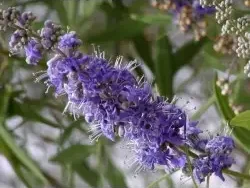
Vitex Agnus-castus: discover its benefits and properties!
What is Vitex used for?
Vitex is effective against depression, helps to stabilise the menopause, reducing nipple pain and improving libido. It occupies the popamine receptors, putting a woman in a good mood. It also helps to combat female infertility by increasing the production of progesterone in women.
Vitex Agnus-castus causes progesterone production to increase, but curiously it has no direct hormonal activity and is therefore not a phytoestrogen.
Similarly, hyperprolactinaemia (excessive prolactin production) is common in women who have been diagnosed as having a defective luteal phase (around 70%), and Vitex Agnus-castus is also ideal for correcting this problem.
Menstrual disorders: This plant is a first for menstrual problems, being a specific problem for menstrual irregularity and premenstrual syndrome. Although there isn’t a problem, you can help relieve symptoms such as breast tension, fluid retention, headaches and premenstrual tension. When you take this plant every few months, the symptoms usually decrease.
It can be used to treat heavy menstrual flow, but works best in combination with other remedies recommended by a professional.
Polycystic ovary disease: Herbal medicine can be very useful in controlling and regressing this difficult problem. Although professional monitoring is best, self-treatment with chastity-light sometimes leads to a significant improvement in symptoms. Results can be seen in 3-4 months.
Infertility: it is thought that active-light-of-chastity regulates the release of oestrogen and progesterone throughout the menstrual cycle, which can improve fertility and increase the chances of conception. It is most effective when there are no structural problems.
Menopausal problems: Useful in the year leading up to the menopause, a-da-castidade helps to maintain a regular menstrual cycle and control the flow. It can also be taken in conjunction with the herb Mulberry Miura to relieve or prevent some menopausal symptoms.
Active Ingredients:
The whole plant: 1,8-cineole, ageneioside, alpha and beta-pinene, aucubin, bornyl-acetate, casticane, eurostoside, isovitexin, limonene, orientin, sabinene, viticinene.
Flowering plants:
flavonoids: casticin, homoorientin; iridoid glucosides: aucuboside, agnoside; tannins, bitter principles.
Fruit: essential oil (0.5%) rich in cineol and pinene, agnoside, aucubin, mussaendosidic acid, enteroside, agnocastoside A, B and C,
Flavonoids: casticin, caempeferol and quercetagin derivatives, penduletin, chrysoplenol, isovitexin and luteolin derivatives;
Essential oils: Monoterpenoids: cineol, alpha and beta pinene, limonene, sabinene, castinum, eucalyptol, myrcene, linalool, citronellol, cymene, camphene. Sesquiterpenoids: farnesene, caryophyllene, cardinene and ledol.
Use as tea: As a diuretic, antidisexual, expectorant, haematuria, haemorrhoids, diabetes, menstrual and menopausal problems, poor lactation, involuntary ejaculation, rheumatism, diarrhoea, gastralgia, amenorrhoea, bronchitis.








Sorry, the comment form is closed at this time.